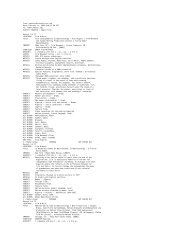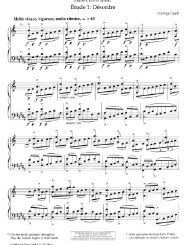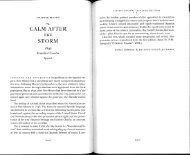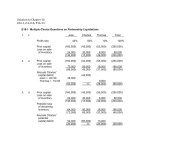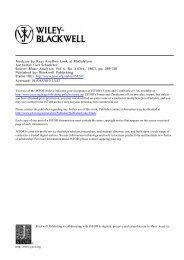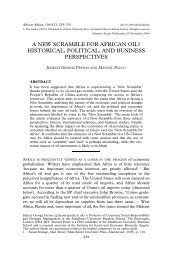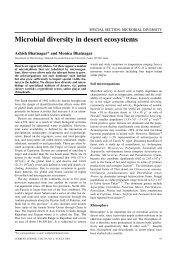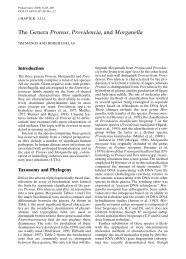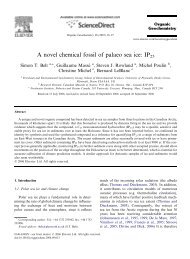The Genus Serratia
The Genus Serratia
The Genus Serratia
You also want an ePaper? Increase the reach of your titles
YUMPU automatically turns print PDFs into web optimized ePapers that Google loves.
CHAPTER 3.3.11 <strong>The</strong> <strong>Genus</strong> <strong>Serratia</strong> 229<br />
Selective Media Based on DNase<br />
Production and Antibiotic Resistance<br />
Farmer et al. 1973 proposed the following deoxyribonuclease-toluidine<br />
blue-cephalothin (DTC)<br />
agar.<br />
DTC Agar for Isolating <strong>Serratia</strong> (Farmer et al., 1973)<br />
Deoxyribonuclease test agar (BBL) 21 g<br />
Agar (Difco) 2.5 g<br />
Toluidine blue O 0.05 g<br />
Distilled water 500 ml<br />
Mix on a mechanical stirrer until the dye dissolves, autoclave<br />
with a Teflon stirring bar at 121°C for 15 min, cool<br />
to 50°C, add 5 ml (500 mg) of cephalothin (Keflin<br />
injectible, Eli Lilly), stir and dispense in sterile petri dishes.<br />
Typically, <strong>Serratia</strong> spp. grow on this blue DTC<br />
medium producing a red halo extending several<br />
millimeters around the colonies. “False negatives”<br />
(no growth or no halo) are very rare<br />
among S. marcescens isolates, but several strains<br />
of S. rubidaea and S. plymuthica failed to give the<br />
proper reaction (Starr et al., 1976).<br />
A medium with DNase test agar, toluidine<br />
blue, cephalothin (30 µg/ml and colistimethate<br />
(30µ/ml) has been proposed by Cate (1972); and<br />
a medium with DNase test agar, toluidine blue,<br />
egg yolk, and cephalothin (100µ/ml) has been<br />
proposed by Goldin et al. 1969. <strong>The</strong> latter combines<br />
DNase and lecithinase detection.<br />
Berkowitz and Lee (1973) devised the following<br />
medium for the isolation of S. marcescens:<br />
DNase Medium for Isolating <strong>Serratia</strong> marcescens<br />
(Berkowitz and Lee, 1973)<br />
Deoxyribonuclease test agar<br />
with methyl green (Difco) 42 g<br />
L-Arabinose 10 g<br />
Phenol red 0.05 g<br />
Methyl green, 1% 4 ml<br />
Distilled water up to 1 liter<br />
After autoclaving, add ampicillin (5 µg/ml), colistimethate<br />
(5 µg/ml), cephalothin (10 µg/ml), and amphotericin<br />
B (2.5 µg/ml).<br />
<strong>Serratia</strong> colonies hydrolyze DNA, and the<br />
green component of the medium’s dark color<br />
disappears around the colonies. S. marcescens (or<br />
S. entomophila), unable to ferment L-arabinose,<br />
will give colonies surrounded by a red halo,<br />
whereas other <strong>Serratia</strong> species will give a yellow<br />
halo. <strong>The</strong> other <strong>Serratia</strong> species, however, may be<br />
inhibited by the antibiotic mixture. Wright et al.<br />
1976 used this medium to isolate and enumerate<br />
S. marcescens from vegetable salads.<br />
Selective Media Based on Carbon-Source<br />
Utilization<br />
A minimal medium with meso-erythritol as<br />
the sole carbon source was devised by Slotnick<br />
and Dougherty (1972). A modification of this<br />
medium that included the antiseptic “Irgasan”<br />
(4′,2′,4′-trichloro-2-hydroxydiphenylether), has<br />
been proposed (Lynch and Kenealy, 1976).<br />
Unfortunately, <strong>Serratia</strong> liquefaciens, S. plymuthica,<br />
S. entomophila, S. proteamaculans biotypes<br />
Clc and RB, S. odorifera biotype 1, and the nosocomial<br />
biotypes A5, A8a, A8b, A8c and TCT of<br />
S. marcescens cannot grow with erythritol as sole<br />
carbon source (Grimont et al., 1977b; Grimont<br />
et al., 1978a; Starr et al., 1976). <strong>The</strong>refore, these<br />
media should not be used in epidemiological or<br />
ecological surveys unless the study is knowingly<br />
limited to erythritol-positive serratiae.<br />
A minimal medium with meso-inositol as sole<br />
carbon source has been proposed for the selective<br />
isolation of Klebsiella pneumoniae and <strong>Serratia</strong><br />
spp. (Legakis et al., 1976). However, only a<br />
few genera and species have been studied by<br />
these authors, and it has been shown (Grimont<br />
et al., 1977b) that Enterobacter aerogenes, E. cloacae,<br />
Erwinia herbicola, and pectinolytic Erwinia<br />
spp. can also grow on a minimal medium with<br />
inositol as sole carbon source.<br />
A caprylate-thallous (CT) agar medium has<br />
been devised for the selective isolation of all <strong>Serratia</strong><br />
species and biotypes. This CT agar, derived<br />
from M70 minimal medium (Véron, 1975), is<br />
made up as follows (Starr et al., 1976):<br />
CT Agar for Selective Isolation of <strong>Serratia</strong><br />
(Starr et al., 1976)<br />
First, a trace element solution (Véron, 1975) is prepared:<br />
H3PO4<br />
1.96 g<br />
FeSO4·7H2O 0.0556 g<br />
ZnSO4·4H2O 0.0287 g<br />
MnSO4·4H2O 0.0223 g<br />
CuSO4·5H2O 0.025 g<br />
Co(NO3)2·6H2O 0.003 g<br />
H3BO3<br />
0.0062 g<br />
Distilled water 1 liter<br />
Store at 4°C (keeps well for at least 1 year). <strong>The</strong>n<br />
the following solutions (solution A and solution B) are<br />
prepared:<br />
Solution A:<br />
CaCl2·2H2O 0.0147 g<br />
MgSO4·7H2O 0.123 g<br />
KH2PO4<br />
0.680 g<br />
K2HPO4<br />
2.610 g<br />
Trace element solution (see above) 10 ml<br />
Caprylic acid<br />
Yeast extract (Difco)<br />
1.1 ml<br />
(5% wt/vol solution) 2 ml<br />
Thallous sulfate 0.25 g<br />
Distilled water up to 500 ml<br />
<strong>The</strong> pH is adjusted to 7.2 with NaOH. Autoclave at 110°C<br />
(or 120°) for 20 min.<br />
Solution B:<br />
NaCl 7 g<br />
(NH4)2SO4 1 g<br />
Agar (Difco) 15 g<br />
Distilled water 500 g



